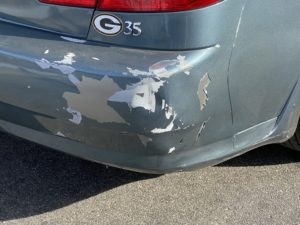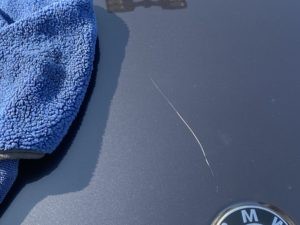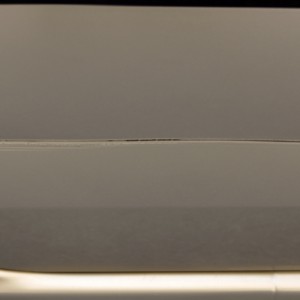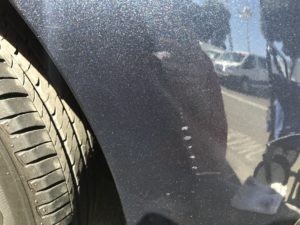How Much Does It Cost to Fix Paint on Car?

Worried about that unsightly blemish on your car’s flawless finish? “How much to fix paint on car?” is a common question. At CARDIAGTECH.NET, we help you understand the factors influencing auto paint repair costs and explore cost-effective solutions to restore your vehicle’s aesthetic appeal. Discover the details to make an informed decision and regain that showroom shine, and perhaps even purchase the tools to do it yourself! We can advise you on your purchase.
1. Assessing the Damage: Identifying the Type of Car Paint Issue
Before diving into the costs, accurately identifying the type of paint damage is essential. This assessment helps determine the appropriate repair method and, consequently, the expense involved. Here are some common types of car paint damage:
1.1 Paint Chips: Small Imperfections, Big Impact
Paint chips are often caused by road debris, gravel, or minor impacts. They range in severity and size:
-
1.1.1 Minor Paint Chips: These are small, typically no larger than a pencil eraser. They are often superficial and relatively easy to fix.
 Minor car paint chips
Minor car paint chips
Alt text: Close-up of minor car paint chips on a vehicle’s surface, highlighting their small size and minimal impact.
-
1.1.2 Extensive Paint Chips: These are larger and may involve cracking or peeling around the chip. They require more extensive repair work to prevent further damage and ensure a seamless finish.
 Extensive peeling car paint
Extensive peeling car paint
Alt text: Example of extensive peeling paint on a car, showing significant damage that requires professional attention.
1.2 Scratches: From Superficial to Deep Gouges
Scratches can range from minor blemishes in the clear coat to deep gouges that penetrate the paint layers and expose the metal underneath.
-
1.2.1 Minor Scratches: These are usually confined to the clear coat and disappear temporarily when wet. They are typically less than 6 inches long.
 Minor scratch on car paint
Minor scratch on car paint
Alt text: Image of a minor scratch on a car, showing its shallow depth and limited visibility.
-
1.2.2 Extensive Scratches: Deeper scratches that extend beyond the clear coat into the paint or even the metal are considered extensive. Scratches longer than 6 inches also fall into this category.
 Extensive scratch damage on a vehicle
Extensive scratch damage on a vehicle
Alt text: Close-up of an extensive scratch on a car, highlighting its depth and potential to reach the metal layer.
1.3 Scrapes: Surface Damage from Abrasive Contact
Scrapes typically result from rubbing against another object, such as a wall or another vehicle.
-
1.3.1 Minor Scrapes: These are superficial and contained within a small area, affecting only the surface of the paint. Sometimes, they may involve paint transfer that can be removed with rubbing compound.
 Minor scrape on a car's surface
Minor scrape on a car's surface
Alt text: Illustration of a minor scrape on a car, demonstrating its superficial nature and limited impact on the paint.
-
1.3.2 Extensive Scrapes: Scrapes that have deformed the car’s surface, cover a large area, or removed paint entirely are considered extensive.
 Extensive scrape damage to car paint
Extensive scrape damage to car paint
Alt text: Visual example of an extensive scrape on a car, showing significant paint removal and potential surface deformation.
1.4 Dents: Structural Damage Affecting Paint
Dents can also cause paint damage, particularly if the impact is significant. It’s crucial to address the dent before repairing the paint to ensure a smooth and lasting finish.
-
1.4.1 Minor Dents: Dents on flat surfaces are generally easier to repair.
-
1.4.2 Extensive Dents: Dents on curved surfaces require more skill and effort to repair. In some cases, if the metal is severely bent, the dent may be irreparable.
 Extensive dent damage on a car panel
Extensive dent damage on a car panel
Alt text: Showcase of an extensive dent on a car panel, emphasizing the complexity of repairing curved surfaces.
2. Car Paint Repair Costs: A Detailed Breakdown
Once you’ve assessed the type and extent of the damage, you can estimate the cost of repair. Here’s a detailed breakdown of the expenses involved:
2.1 Minor Damage Repair Costs
For minor paint chips, scratches, and scrapes, mobile technicians offer a convenient and cost-effective solution.
- 2.1.1 Mobile Technicians: These professionals come to your location and typically charge between $150 and $250 for repairing all minor damage on your vehicle.
- 2.1.2 Touch-Up Repairs: Touch-up repairs are ideal for small, shallow chips and scratches. While they may not restore the car to a brand-new condition, they significantly improve its appearance and prevent further damage.
- 2.1.3 Dent Repairs: Mobile technicians usually charge around $75 per panel for dent repairs.
For reliable paint repair, consider technicians who use the Dr. Colorchip system. This system provides high-quality color matching and durable results.
2.2 Extensive Damage Repair Costs
Extensive paint damage requires more comprehensive repair methods, such as spraying.
- 2.2.1 Mobile Spray Paint Services: For moderate damage on vertical surfaces like car doors, mobile spray paint services can be a good option. These services typically cost between $200 and $400 and are suitable for damage on multiple panels.
- 2.2.2 Body Shops: If the damage is on a horizontal surface like the hood or is too extensive for touch-up or mobile spray painting, a body shop is necessary. Body shops have controlled environments to ensure a high-quality finish.
Body shops typically charge between $250 and $600 per panel, depending on your location and the shop’s reputation.
2.3 Factors Affecting Car Paint Repair Cost
Several factors can influence the final cost of car paint repair:
- Type and Extent of Damage: As discussed above, the more severe the damage, the higher the cost.
- Vehicle Make and Model: Some car makes and models have more complex paint systems or require specialized paints, which can increase repair costs.
- Paint Color: Matching the exact paint color is crucial for a seamless repair. Some colors, especially those with metallic or pearl finishes, are more challenging to match and may require more time and materials, thus increasing the cost.
- Repair Method: The chosen repair method significantly affects the cost. Touch-up repairs are cheaper than full panel repainting.
- Location: Labor rates and material costs vary by location. Urban areas typically have higher rates than rural areas.
- Shop Reputation and Expertise: Established and reputable body shops often charge more due to their expertise and quality of service.
- Additional Services: If dent repair or rust removal is needed in addition to paint repair, the overall cost will increase.
3. DIY Car Paint Repair: Is It a Viable Option?
For minor paint imperfections, DIY car paint repair can be a cost-effective solution. However, it requires careful preparation, the right tools and materials, and attention to detail. Here’s an overview:
3.1 When to Consider DIY Repair
DIY repair is suitable for:
- Small Paint Chips: Minor chips that haven’t penetrated the primer layer.
- Superficial Scratches: Light scratches in the clear coat.
- Minor Scrapes: Small surface abrasions.
3.2 Tools and Materials for DIY Car Paint Repair
To perform DIY car paint repair, you’ll need the following tools and materials:
- 3.2.1 Cleaning Supplies: Car wash soap, microfiber cloths, and degreaser to clean the area.
- 3.2.2 Sandpaper: Fine-grit sandpaper (2000-3000 grit) for smoothing the damaged area.
- 3.2.3 Touch-Up Paint: Matching touch-up paint for your car’s color code.
- 3.2.4 Clear Coat: Clear coat to protect the paint and provide a glossy finish.
- 3.2.5 Rubbing Compound: Rubbing compound to blend the repaired area with the surrounding paint.
- 3.2.6 Polishing Compound: Polishing compound to restore the shine.
- 3.2.7 Applicators: Small brushes, foam applicators, or paint pens for applying the paint and clear coat.
- 3.2.8 Safety Gear: Gloves and a mask to protect yourself from chemicals and fumes.
3.3 Step-by-Step Guide to DIY Car Paint Repair
- Clean the Area: Wash the area around the damage with car wash soap and water. Remove any wax or grease with a degreaser.
- Prepare the Surface: Use fine-grit sandpaper to smooth the edges of the damage. Be gentle and avoid removing too much paint.
- Apply Touch-Up Paint: Apply thin coats of touch-up paint to the damaged area, allowing each coat to dry before applying the next.
- Apply Clear Coat: Once the paint is dry, apply a thin layer of clear coat to protect the paint and provide a glossy finish.
- Sand and Buff: After the clear coat is dry, use fine-grit sandpaper to smooth any imperfections. Then, use rubbing compound and polishing compound to blend the repaired area with the surrounding paint.
- Wax: Apply a coat of wax to protect the repaired area and enhance the shine.
3.4 Potential Pitfalls of DIY Repair
While DIY repair can save money, it’s important to be aware of the potential pitfalls:
- Color Matching: Getting an exact color match can be challenging, especially with older vehicles or custom paint jobs.
- Uneven Finish: Achieving a smooth, even finish requires skill and practice.
- Further Damage: Improper sanding or application of paint can worsen the damage.
- Time and Effort: DIY repair can be time-consuming, especially for larger areas or multiple imperfections.
4. Cost-Saving Tips for Car Paint Repair
If you’re looking to save money on car paint repair, consider these tips:
- Get Multiple Quotes: Obtain quotes from several body shops and mobile technicians to compare prices.
- Consider Mobile Repair: Mobile repair services are often more affordable than body shops for minor damage.
- Opt for Touch-Up: Touch-up repairs are a cost-effective solution for small chips and scratches.
- Repair Damage Early: Addressing paint damage early can prevent it from worsening, which can lead to more expensive repairs down the road.
- Maintain Your Car’s Paint: Regularly washing and waxing your car can protect the paint from damage and extend its life.
- Check for Insurance Coverage: Review your insurance policy to see if paint damage is covered. Some policies cover paint repairs, especially if the damage was caused by an accident or vandalism.
5. Maintaining Your Car’s Paint: Prevention is Key
Preventing paint damage is always better than repairing it. Here are some tips for maintaining your car’s paint:
5.1 Regular Washing and Waxing
Washing your car regularly removes dirt, grime, and other contaminants that can damage the paint. Waxing provides a protective layer that helps to repel water, UV rays, and other harmful elements.
5.2 Avoid Harsh Chemicals
Avoid using harsh chemicals or abrasive cleaners on your car’s paint, as they can strip away the protective layers and cause damage.
5.3 Park in Shaded Areas
Parking in shaded areas can protect your car’s paint from the harmful effects of the sun’s UV rays, which can cause fading and cracking.
5.4 Use Car Covers
When parking your car outside for extended periods, use a car cover to protect it from the elements.
5.5 Address Damage Promptly
Addressing paint damage promptly can prevent it from worsening and save you money on repairs in the long run.
6. The Importance of Professional Car Paint Repair
While DIY car paint repair can be a viable option for minor imperfections, professional repair is often necessary for more extensive damage. Here’s why:
6.1 Expertise and Experience
Professional technicians have the expertise and experience to properly assess the damage and choose the appropriate repair method.
6.2 Specialized Tools and Equipment
Body shops have specialized tools and equipment, such as spray booths and color-matching systems, to ensure a high-quality finish.
6.3 Quality Materials
Professional technicians use high-quality paints and materials that are designed to last and provide a durable finish.
6.4 Warranty
Many body shops offer a warranty on their work, giving you peace of mind knowing that the repair is guaranteed.
7. Finding a Reputable Car Paint Repair Shop
Choosing a reputable car paint repair shop is crucial for ensuring a high-quality repair. Here are some tips for finding a good shop:
7.1 Ask for Recommendations
Ask friends, family, and colleagues for recommendations.
7.2 Read Online Reviews
Read online reviews on sites like Google, Yelp, and Facebook.
7.3 Check for Certifications
Look for shops that are certified by organizations like I-CAR (Inter-Industry Conference on Auto Collision Repair).
7.4 Visit the Shop
Visit the shop in person to inspect the facility and talk to the technicians.
7.5 Get a Written Estimate
Get a written estimate that includes a detailed breakdown of the costs.
8. Understanding Car Paint Types
Understanding the different types of car paint can help you make informed decisions about repair and maintenance. Here’s an overview:
8.1 Single-Stage Paint
Single-stage paint consists of a single layer of color and does not have a clear coat. It’s less durable and prone to fading.
8.2 Base Coat/Clear Coat
Base coat/clear coat systems consist of a base coat that provides the color and a clear coat that protects the paint and provides a glossy finish. This is the most common type of paint used on modern cars.
8.3 Tri-Coat Paint
Tri-coat paint systems consist of a base coat, a mid-coat that adds depth and shimmer, and a clear coat. These systems are more complex and expensive to repair.
9. Car Paint Repair vs. Replacement: Which is Right for You?
In some cases, you may need to decide between repairing the paint or replacing the damaged panel. Here’s a comparison:
9.1 Car Paint Repair
- Pros: More affordable, faster turnaround time, retains original parts.
- Cons: May not be possible for extensive damage, color matching can be challenging.
9.2 Panel Replacement
- Pros: Restores the car to like-new condition, ensures a perfect color match.
- Cons: More expensive, longer turnaround time, may affect the car’s resale value.
10. CARDIAGTECH.NET: Your Partner in Automotive Care
At CARDIAGTECH.NET, we understand the importance of maintaining your vehicle’s appearance and value. Whether you’re a seasoned auto repair professional or a DIY enthusiast, we offer a comprehensive range of tools and equipment to help you achieve outstanding results.
10.1 High-Quality Automotive Tools and Equipment
We source our products from leading manufacturers, ensuring exceptional quality, durability, and performance. Our extensive inventory includes:
- Paint Repair Kits: Comprehensive kits with everything you need for professional-quality touch-ups.
- Spray Guns: Precision spray guns for flawless paint application.
- Sanders and Polishers: High-performance tools for surface preparation and finishing.
- Diagnostic Tools: Advanced diagnostic tools to identify and address any underlying issues.
10.2 Expert Advice and Support
Our team of experienced professionals is dedicated to providing expert advice and support. We can help you choose the right tools for your specific needs and offer guidance on proper techniques and best practices.
10.3 Competitive Pricing and Fast Shipping
We offer competitive pricing on all our products, ensuring you get the best value for your investment. With fast shipping and reliable service, CARDIAGTECH.NET is your trusted partner for all your automotive needs.
11. Frequently Asked Questions (FAQs)
-
How much does it cost to fix a scratch on a car?
The cost to fix a scratch on a car ranges from $150 to $250 for minor scratches and $250 to $600 per panel for extensive scratches. -
How much does it cost to fix a paint chip on a car?
The cost to fix a paint chip on a car ranges from $150 to $250 for minor chips and $250 to $600 per panel for extensive chips. -
Is it worth it to fix paint damage on a car?
Yes, fixing paint damage is worth it to maintain your car’s appearance, prevent further damage, and retain its value. -
Can I fix car paint damage myself?
Yes, you can fix minor car paint damage yourself with the right tools and materials. However, professional repair is recommended for extensive damage. -
How do I choose the right touch-up paint for my car?
Use your car’s color code to find the matching touch-up paint. The color code is usually located on a sticker in the driver’s side doorjamb or in the glove compartment. -
How long does it take to fix paint damage on a car?
The time it takes to fix paint damage on a car depends on the extent of the damage and the repair method. Minor repairs can be completed in a few hours, while extensive repairs may take several days. -
Will fixing paint damage increase my car insurance rates?
Fixing paint damage may increase your car insurance rates if you file a claim. However, if you pay for the repair out of pocket, it will not affect your rates. -
What is the best way to prevent car paint damage?
The best way to prevent car paint damage is to wash and wax your car regularly, avoid harsh chemicals, park in shaded areas, and use car covers. -
What is the difference between single-stage and base coat/clear coat paint?
Single-stage paint consists of a single layer of color, while base coat/clear coat systems consist of a base coat that provides the color and a clear coat that protects the paint and provides a glossy finish. -
How do I find a reputable car paint repair shop near me?
Ask for recommendations, read online reviews, check for certifications, visit the shop, and get a written estimate.
Conclusion: Restoring Your Car’s Beauty
Understanding the costs associated with car paint repair empowers you to make informed decisions and choose the best option for your needs. Whether you opt for DIY repair or professional service, addressing paint damage promptly can preserve your vehicle’s appearance and value. Remember, prevention is key. Regular maintenance, such as washing and waxing, can protect your car’s paint from damage and extend its life.
Ready to take the next step? Contact CARDIAGTECH.NET today at 276 Reock St, City of Orange, NJ 07050, United States or call us on Whatsapp at +1 (641) 206-8880 for expert advice and a wide range of automotive tools and equipment. Let us help you restore your car’s beauty and maintain its value. Visit CARDIAGTECH.NET for all your automotive needs. We’re here to help you make your car look its best.





